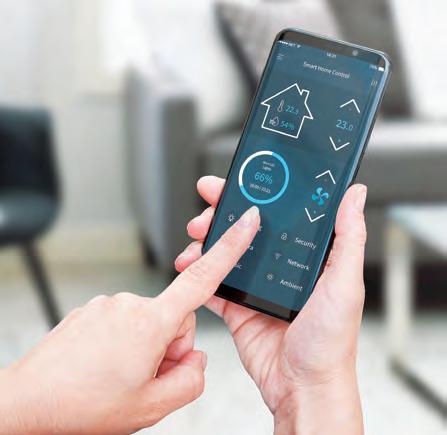
6 minute read
Spotlight on 2021 interior trends
TRENDING NOW 2020 has changed the way we live and work. How will this affect what is specified in 2021? Hannah Cooper examines door-related trends for the coming year.
As 2020 draws to a close, we are looking forward to a new, hopefully more positive, year ahead. This year has certainly been one of change and reflection. For many people, there has always been a clear differentiation between home and work, but 2020 has led to a rethink about what these spaces need to deliver now and in the future.
Advertisement
Door designer and manufacturer Masonite UK - who own Premdor, Solidor, Door-Stop International and National Hickman - have explored what we can expect to see in 2021 and how this will impact what people want from their doors over the coming years…
Flexible living spaces
For many people there is currently little separation between home and work. According to data from Finder*, 60% of adults in the UK have been working from home since the start of lockdown, and 26% would like to continue working from home into the future.
A home must now deliver a multifunctional space. Living spaces are also acting as the gym, social and leisure venues, as well as a place to relax – all while providing a suitably stylish Zoom background.
Although open plan living has been on the rise, people are now looking for a distinct space to work and doors play a critical role in providing this extra level of separation. Simple design changes can help to create separate spaces, without compromising on the light and airy feel that open plan living offers.
For external doors, a contrasting colour door frame paired with a full or half height glazed side panel can be used to create an interesting design while enhancing the amount of natural light entering the property.
Matching glazed exterior and interior doors together will help maintain the open feeling throughout the home while still offering the required separation. Premdor’s Canadian and Manhattan range offers a variety of glazed internal doors, from two and half light options to almost entirely glass.
Left: Working from home – a trend set by the Covid-19 pandemic – looks set to stay. Below: The digital home controlled by smart phone is on the rise Right: Stable doors is one way to allow the outside inside
As an alternative to permanent glazing, homeowners may prefer a stable door. Solidor’s standard and Italia Collection ranges can be integrated into a stable style door and can be customised to be different colours on each side.
These types of door offer an additional level of ventilation, and are fitted with a high security, fully adjustable, multipoint locking system with an interlocking door bolt to secure the top and bottom halves of the door together.
Environmental awareness
Consumers have started to shift away from material things and are choosing instead to focus on experiences and the wider impact of products. They are looking for products that deliver long-term economic and social value; buying locally, choosing sustainably sourced materials and sharing resources among the local community.
Consumers are also increasingly happy to invest in a slightly more expensive products that will stand the test of time and save them money in other areas, such as heating and electricity bills. Research from Money. co.uk** has revealed that UK’s homeowners have spent an average of £4,035.70 on renovations since lockdown began in March.
One example is home improvement products that can also help to save energy costs through better insulation. A good indicator of how effective a door is as an insulator is its U-Value. The lower the U-value is, the better the material is at keeping the heat in. The required building standards for composite door manufacture is 1.8Wm2/K or less. Both Door-Stop International and Solidor offer a range of composite doors with a mixture of cores that offer impressive thermal performance.


The digital home
The Smart Home, also known as the Connected Home, provides a practical way of managing electronic devices from any location. Incorporating a range of safety and security systems, energy equipment and appliances, homeowners can now control most things in their home with a smart phone.
Initially used by tech savvy individuals, smart home technology - like Amazon Alexa, Google Assistant, Nest and Hive - has now become more mainstream, and the benefits of having a Smart Home more widely known.
This technology has started to move over to the door sector, with innovations such as the Ring doorbell becoming increasingly popular with
Open plan living is a continuing trend

As we look ahead to 2021 and beyond, the balance of time spent in our homes and place or work will have shifted forever.”
homeowners. Digital Trends magazine recently announced its best smart locks for 2020, choosing the August Wi-Fi Smart lock as the overall winner and the Level Touch for the best design.
The Level Touch is particularly interesting as it does not look like typical smart lock technology. It can be used to upgrade the existing deadbolt and lock, and can be activated by either touching the lock’s frame (which is linked with Bluetooth and recognises when a registered smart phone is near), an app, or even specific NFC-enabled key cards that can be controlled via the app.
This trend will continue for many years to come as smart products continue to evolve. In the future, digital eye viewers and smart phone controlled access systems will be the norm. As more and more consumers adopt these products in their home, they will expect other products to be responsive to and compatible with the latest technology.
As we look ahead to 2021 and beyond, for many of us the balance of time spent in our homes and in a designated place of work will now have shifted forever. Products and technologies that can make our working and home lives more comfortable and secure will remain important for the foreseeable future. n
*Research conducted by Finder, September 2020 **Research conducted by Money.co.uk July 2020
TOP 5 INTERIOR DESIGN AND ARCHITECTURE TRENDS
The five style trends that will trickle down to doors, windows and hardware spec
Sustainability
Sustainability has been a growing trend for the past 10 years, and it shows no signs of going away. Don’t be surprised if you’re increasingly required to work on passive design, account for carbon footprint and make adjustments for increasingly sophisticated ecotechnology. fitness, mind, and
Uber tech
Smart access will continue to grow – increasingly entering the residential sector and commercial as more work space becomes shared and flexible. Covid 19 has seen a huge demand in healthprotecting hardware, which will also continue.
Healing architecture
The current buzzword is ‘wellness architecture’ – buildings designed with mental and physical wellbeing in mind. Health Organisation, people spend on average 90% of their time indoors so it is imperative that the buildings they work, rest and play in benefit their health.
The WELL Building Standard administered by the International WELL Building Institute (IWBI) has sprung from this position. Developed in the States it is currently mainly for commercial and institutional office buildings, but has pilot programmes in other sectors.
There are seven categories in which a space must receive satisfactory scores in order to become WELL certified. They are air, water, light, nourishment, According to the World
comfort which are audited on site. Expect more demand for this type of space which will impact on window and product specification.
Open plan space
In work places and homes this trend is designed to foster connectivity and interaction. But flexible space and ability to ‘redraw’ spaces will be part of the demand so will impact on door choices. See the point below.
Quiet spaces
In both homes and officse there is an increasing demand for spaces to retreat to for privacy or meditation. Use of windows, acoustic seals and materials will be key.











